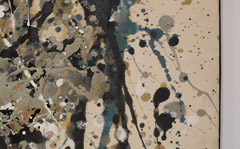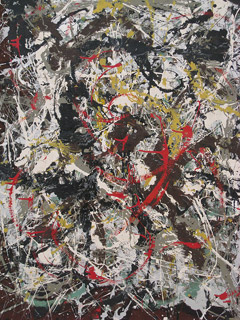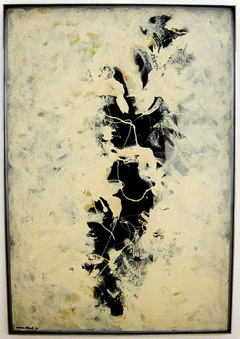Jackson Pollock
 Born in Cody, Wyoming on January 28th 1912, Paul Jackson Pollock was born to a father who was a government surveyor and farmer and a mother of fierce character and artistic ambition. Pollock was a needy child, the youngest of five other brothers. Throughout his youth, the Pollock family moved through California and Arizona. Pollock’s father was an alcoholic and abusive. He left the family when Pollock was 8 years old.
Born in Cody, Wyoming on January 28th 1912, Paul Jackson Pollock was born to a father who was a government surveyor and farmer and a mother of fierce character and artistic ambition. Pollock was a needy child, the youngest of five other brothers. Throughout his youth, the Pollock family moved through California and Arizona. Pollock’s father was an alcoholic and abusive. He left the family when Pollock was 8 years old.

Pollock moved to New York City aged 18 to live with brother Charles. He began to study art with Thomas Hart Benton, a painter who also tutored Charles. Pollock spent increasing amounts of time in the Benton household, eventually integrating into the family, such was the closeness between student and master.
Pollock’s father died in 1933, and as a result of his father’s death into a dark depression. While drunk, he picked a fight with his brother Charles’s wife, Elizabeth. Pollock threatened her with an axe, and slashed a painting of his brother’s. Pollock was expelled from Charles’s house, and another brother Sanford took over Pollock’s care.
The Depression
Jackson Pollock was involved in an economy kick start programme called the “Public Works of Arts Project” initiated by President Franklin. He received $24 for 20 hours of work each week. This programme resulted in works of art by the thousands by Pollock and his contemporaries on the programme.

Adult Life
Pollock met Lee Krasner, a Jewish contemporary artist and became involved romantically. Peggy Guggenheim was at this time taking an interest in Pollock’s work. She put him into a contract after the painter Pete Norman stated that Pollock’s work was possibly the most original American art he had seen.

The “Drip Period”
This period was responsible for the creation of some of the finest works by Pollock. Between 1947 and 1950, he became incredibly popular after Life magazine had run a four page spread on him. The article posed the question “Is he the greatest living painter in the United States?” Overnight Pollock’s life changed with many artists resenting his fame. As his fame grew wider he was called for a fraud by certain art critics which led to a confidence crisis where he would rely on Krasner to pick which of his paintings were good.
After a sell-out show at the Betty Parsons Gallery, Pollock was the most highly paid avant-garde painter in the United States. Fame however did not suit Pollock, who became dismissive of his former mentors and other artists. He felt like a fake in interviews and self-promotion and eventually returned to heavy drinking. His next major show was not a sell-out although paintings such as “Number 4, 1950,” are now considered a masterpiece.

Concerned for Pollock’s health and sanity, his mother intervened, bringing some stability to her son’s life. Painting again, Pollock produced the masterpiece, “The Deep“.
Downfall
Pollock’s wife was smothered by the needs of Pollock’s needs and the increasing pressure he was under and the marriage fell into troubled waters. Pollock’s health was failing and he was seeing other women. By 1956, he stopped painting, and Krasner went to Paris hoping to give Pollock space to sort himself out.
On the night of August 11, 1956, Pollock, who was drunk, crashed his car into a tree. His girlfriend survived after being thrown from the car, another passenger was killed and Pollock died after being thrown from the car into a birch tree.
